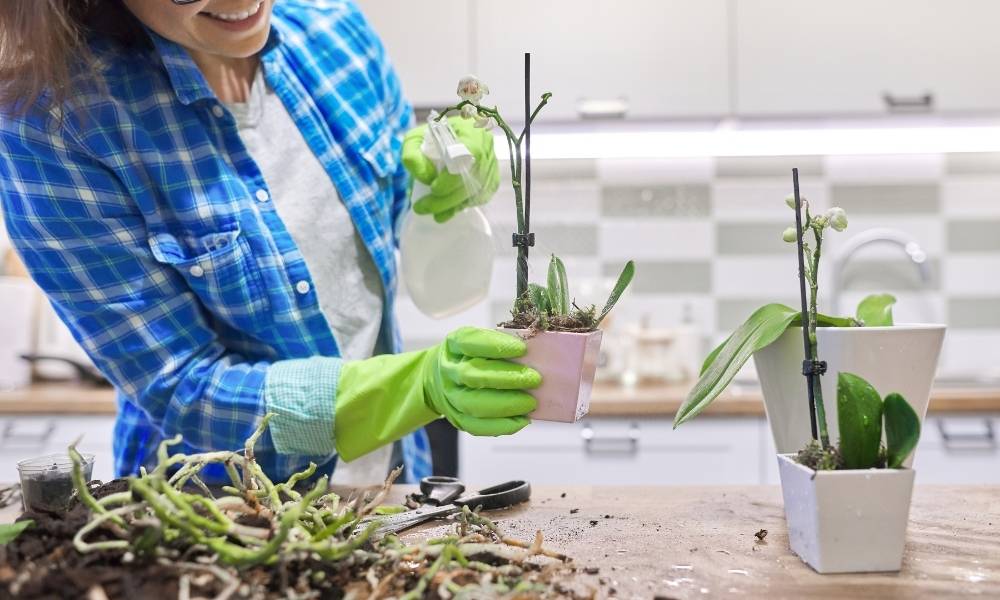Orchids are one of the most eccentric and fascinating kinds of plants in the plant world. This section offers descriptions, images and valuable advice on many species of orchids, beautiful plants with indisputable charm. Numerous genera and varieties are part of the Orchidaceae family. It is therefore very difficult to give an overall description. They are widespread all over the planet, with the exception of the Poles and deserts. Most of them live in the tropical and subtropical wetlands of the planet, but they are also widespread in Italy in the wild. The most common, the epiphytes, live clinging to trunks, branches and rocks covered with moss.
However, there are also some that have underground rhizomatous roots. Orchids have linear and whole leaves, usually alternating.
The flowers can be solitary or collected in racemes, composed of three sepals and three petals. One of these is called labellum, the shape of which varies according to the species. Its purpose is to attract pollinating insects.
Epiphytic species are characterized by aerial roots which, thanks to a particular coating, are able to absorb environmental humidity, vital for their survival.
| Family and gender | Family. Orchidaceae |
| Exposure | They generally love the bright shade |
| Rustic | Most don’t. Only 10-15% live in temperate or rigid areas. |
| Type of plant | Perennial herbaceous.Epiphytes, with aerial or terricolous roots, therefore bulbous or rhizomatous
|
| Colors | White, pink, red, yellow, green, purple. |
| Height | From 10 cm to several meters for climbing plants |
| Propagation | Sowing, division. |
Types Or Orchids
Generally speaking, orchids are divided into three categories based on their climatic needs. It is essential for all that there are changes in temperature throughout the year because this simulates the changing of the seasons and stimulates flowering.
Cold greenhouse orchids
They are plants that originally live at quite high altitudes. Ideal temperatures range from 10 to 15 ° C.
Temperate greenhouse orchids
The most suitable for cultivation in the apartment because they do not require special equipment to make them live properly. The ideal is that they are kept at around 15 ° C in winter. In summer, a temperature of around 20 ° is recommended
Hot greenhouse orchids
In winter they need about 18 ° C. During the vegetative period, however, they require about 5 degrees more to be able to stimulate them adequately and therefore bring them to bloom.
How To Care For Orchids
Almost all orchids live in very bright shade in nature. They usually grow clinging to trees and can enjoy the shade of their leaves. If we want to cultivate them we must provide them with the same conditions. In winter they can also be exposed to direct light. In summer, however, they should be placed in a bright place near windows. The light, however, must be filtered by curtains so that it does not damage the leaves. An excellent alternative is, in the summer season, to place them outside. The ideal is a position where a lot of light arrives, but filtered by the leaves of other plants.
The best choice is to use transparent plastic pots (which makes it easy for us to check the state of the roots). The most suitable substrate is the specific pine bark (not too resinous) because it retains moisture, but also allows air to circulate. Other materials can be: coconut fiber, perlite, polystyrene, pumice. Epiphytes can also be grown on a “raft”, ie made to cling to pieces of wood bark (as they would in nature).
How often should you water orchids?
Each orchid has its own needs, but general advice can be given: first of all it is better to avoid watering too much and if we have any doubts it is better to wait a few more days before proceeding. Especially for epiphytes, the ideal to understand when it is time to irrigate is to feel the weight of the pot. We will only proceed when this is very light (and the roots are silvery).
It is always best to avoid getting the collar and pseudobulb wet (because rots are a real danger). An excellent method is immersion: insert the pot in a basin with a few centimeters of water and wait for the substrate to soak. The water must be as limescale-free as possible: water from softeners, rainwater or even from reverse osmosis (for example the one on sale for irons).
How to fertilize orchids?
It is good to regularly fertilize orchids with a specific product. The ideal is to always add a small dose of fertilizer to both the water we use for irrigation and the one we use to vaporize them.
In nurseries and garden centers you can find very valid products for fertilization, such as fertilizer for orchids, a specific fertilizer made with concentrations of NPK (nitrogen, phosphorus and potassium) ideal for the needs of orchids.
The fertilizer for orchids must have a ratio of 30 10 10 in the first phase of spring, when new branches and new vegetative parts develop from the plant. During the rest of the year, use a 20-20-20 fertilizer while for flowering and immediately after repotting the best enthusiasts of these plants usually recommend a 10-30-20.
In addition to nitrogen, phosphorus and potassium for these plants, calcium is also very important, to be administered all year round in the form of calcium nitrate. The orchids we grow need, as in nature, high atmospheric humidity, usually around 60%. Keep in mind that the higher the temperature, the higher the humidity required.
It is therefore excellent to use electric humidifiers or to vaporize the plant several times a day with sprayers. If we keep the plants outside, we can also wet the floor where they are placed so that the evaporation of the water maintains the ideal humidity in that area.
The Orchid is a particularly delicate plant which, also for this reason, requires particular attention and dedication, but also simple precautions. To prevent the fall of the leaves, for example, a thoughtful watering is fundamental, which must not however become insufficient: this would in fact cause a stop of the development of the plant with consequent fall of the flowers.
Orchid Diseases
The disease that most affects the orchid is certainly the one characterized by the symptom of brown spots that indicate the presence of Cochineals which can be brown or cottony: these are stubborn killer insects that must be affected at the origin to be eliminated. starting from the direct and targeted intervention. The first effective advice is to pass a cotton swab impregnated with alcohol on the leaves.
The blue orchid is one of the most searched types of orchids in nurseries and flower shops. Many people love to give orchids of this color because they are beautiful and because it is a color that brings serenity. But what are the blue orchids that are most often given away?
The Vanda coerulea is the blue orchid par excellence, known by all with the name of blue orchid for the color of its petals. It is an orchid of spontaneous tropical origin in India, Thailand and Burma which in Italy can be grown indoors or outdoors in the warmer months. The blue orchid in fact needs external temperatures of at least 10-18 ° C during the night and 20-30 ° C during the day to vegetate optimally.
There are also some beautiful blue phalaenopsis on the market that are becoming popular in recent years because they enchant all flower lovers thanks to their unusual and bewitching color. Blue phalaenopsis are unusual and rare to find but in reality they are obtained artificially, i.e. by giving some dye through watering that gives the petals of the phalaenopsis a special color.
The blue of the phalaenopsis is more intense than the color of the Vanda coerulea but unlike the latter, it fades over time and does not last. In fact, the blue color, obtained in an artificial way, gradually disappears if you stop giving the dye to the plants. Many people who approach the world of orchids and their fascinating world, ask the most experts which are the most cultivated types of orchids . The most cultivated types, even if in technical jargon they would be called genera, are the phalenopsis orchids, the cymbidiums and the vandas.
These three types of orchids can be found in any well-stocked nursery and almost any florist. They are available all year round and are ideal as a gift because they have a prolonged flowering, are equipped with exotic and fascinating shapes and colors and are indoor plants that can divinely decorate the house.

Phalaenopsis are certainly the most appreciated and sought after genus due to their very delicate and particular shapes, and for their long-lasting flowering.
Final Thoughts
Orchids are one of the most elegant and classic flowers that you can give as a gift, but they also require some extra care to keep them looking beautiful. With a little bit of knowledge and some basic care, you can keep your orchids healthy and blooming for years to come. Thanks for reading!
We hope you enjoyed this article on orchids. If you have any questions or comments, please leave them below!
Further Reading: https://www.growingreenhouse.com/can-you-grow-orchids-in-a-greenhouse-how-to-guide/

Craig Sandeman is South Africa’s go-to guru for all things gift-giving, blending psychology and cultural insights to curate perfect presents. A Cape Town native with a global perspective, he’s renowned for his blog, workshops, and media features that delve into the art and science of thoughtful gifting. If you’re ever stumped on finding the ideal gift, Craig’s expert advice is your ticket to gifting success.








